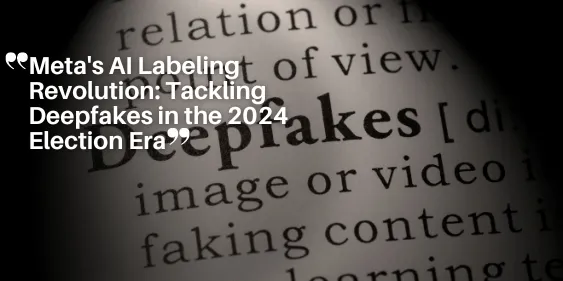Meta’s AI Labeling Revolution: Tackling Deepfakes in the 2024 Election Era

Growing Sophistication of Deepfake Content and AI-Driven Misinformation
The emergence of deepfake technology has ushered in a new era of digital deception.
These AI-generated imitations can convincingly replicate human voices and appearances, making it increasingly difficult to distinguish between real and synthetic media.
This growing sophistication raises significant concerns over the spread of misinformation.
Blurring Lines Between Authentic and Synthetic Media
With the lines between authentic and synthetic content becoming more blurred, the challenge of detecting manipulated media is paramount.
The realism of deepfakes has advanced to such an extent that even seasoned digital natives find it hard to spot the difference.
As these technologies become more accessible, the proliferation of deepfake content is set to grow.
Implications for the 2024 Presidential Elections
The impending 2024 presidential elections add a layer of urgency to this issue.
Historically, election periods have been prime targets for misinformation campaigns.
AI-driven content can spread falsehoods rapidly, potentially influencing voter opinions and the overall election outcome.
The deployment of robust measures to counter this threat is crucial to preserving the integrity of democratic processes.
All these factors underscore the pressing need for platforms like Meta to adapt their policies and technologies to address the unique challenges posed by deepfakes and AI-driven misinformation.
Meta’s New AI Labeling Strategy
Introduction of ‘Made with AI’ Labels
Meta, formerly known as Facebook, is stepping up in the fight against AI-driven misinformation.
Starting March 2024, Meta will introduce “Made with AI” labels across its platforms.
These labels aim to clearly mark content generated by artificial intelligence, including videos, audio, and images.
This labeling initiative is designed to help users identify and critically evaluate AI-generated media.
Expansion to Include Video, Audio, and Image Content
The new “Made with AI” labels won’t just be limited to videos.
Meta plans to expand this system to cover audio and still image content as well.
This is a significant progression from Meta’s earlier policies, which mainly focused on video content.
Given the rapid advancements in AI technology, extending labels to all forms of media is a necessary move.
Scheduled Rollout in March 2024
Meta’s enhanced AI labeling strategy is set to roll out in March 2024.
This timing is crucial, especially with the upcoming 2024 presidential elections.
By implementing these labels ahead of the election cycle, Meta aims to mitigate the risk of AI-driven misinformation influencing voter opinions. The goal is to maintain the integrity of democratic processes by ensuring that voters have access to authentic and trustworthy information.
Looking ahead, the next topic will delve into a significant incident that catalyzed the need for this new labeling strategy.
Catalyst for Change: The Biden Video Incident
The manipulated video of President Biden that circulated in early 2023 served as an alarming wake-up call.
This video, which depicted the president speaking inaccurately on a critical issue, was AI-generated and spread rapidly across social media. Such incidents highlight the fragility of public trust in digital content and expose the limitations of existing policies.
Scrutiny from Meta’s Oversight Board
Meta’s Oversight Board, an independent watchdog funded by Meta, scrutinized the company’s policies following the Biden video incident.
The Board criticized the narrow focus that Meta’s policies had on video content.
This critique forced Meta to confront the reality that their framework did not adequately address the evolving landscape of AI-generated content. The spread of this particular video, which eluded Meta’s detection mechanisms, spotlighted these gaps.
Criticism of Previous Policies
Historically, Meta’s approach to combating misinformation concentrated heavily on video content.
This strategy, while a step in the right direction, was insufficient in the face of advancements in synthetic media.
Manipulated audio and images increasingly fell outside the purview of Meta’s policies, rendering them vulnerable to exploitation.
The Oversight Board’s critique emphasized this inadequacy, pointing out that the emergent capabilities of AI required a more comprehensive policy framework.
Policy Inadequacies
Acknowledging the limitations of their existing approach, Meta pledged to evolve its strategy.
Monika Bickert, Meta’s Vice President of Content Policy, publicly concurred with the Oversight Board’s assessment.
She recognized that Meta’s policies could no longer afford to remain static and required a dynamic overhaul to keep pace with technological evolution.
The expanded scope of their AI labeling strategy now includes all forms of media, ensuring that no manipulated content goes unaddressed.
As Meta moves forward, the onus is not only on detecting and labeling AI-generated content but also on ensuring users are well-equipped to understand this information.
In the ongoing battle against misinformation, both technological advancements and public awareness play crucial roles.
Significance of AI Labeling in Political Discourse
Empowering Users to Discern Content Authenticity
The introduction of AI labels empowers users, giving them the tools they need to distinguish between authentic and synthetic media.
As deepfakes become more convincing, it’s critical that viewers can easily identify AI-generated content.
This helps in fostering an informed user base that can critically assess the information they come across online.
By marking content with a “Made with AI” label, Meta aims to transparently disclose the nature of media, encouraging users to question and validate what they see and hear.
Mitigating the Spread of Misinformation During Election Cycles
Election periods are particularly vulnerable to misinformation, which can sway public opinion and impact election outcomes.
AI labeling plays an essential role in curbing the spread of false information.
By signaling to users that certain content has been generated or altered by AI, Meta seeks to stymie the viral spread of deceptive media.
This proactive approach is crucial in an era where misinformation campaigns are sophisticated and widespread.
Preserving the Integrity of Democratic Processes
The integrity of democratic processes hinges on the availability of accurate information.
AI labeling helps maintain this integrity by ensuring users are aware of the potential synthetic nature of some content.
In an age where deepfakes can easily mimic real individuals and events, such transparency is necessary to protect democratic values.
Meta’s strategy underscores the importance of truth in discourse, aiming to uphold the principles of fair and free elections by making it harder for misinformation to take root.
As we consider these initiatives, it’s evident that there’s more to be done to address the deceptions wrought by sophisticated AI content.
The next logical step is to explore the various challenges Meta faces in implementing these AI labels and how ongoing technological innovation is crucial for robust detection mechanisms.
Challenges in Implementing AI Labeling
Potential for ‘Label Blindness’ Among Users
Implementing AI labels like “Made with AI” sounds great in theory, but it’s not perfect.
One of the main issues centers around “label blindness.” Users might become desensitized to these warnings, much like we’ve become immune to pop-up ads.
When that happens, the labels won’t achieve their goal of making users more cautious about the content they’re viewing.
This potential for desensitization is a significant challenge for Meta and other platforms aiming to implement similar measures.
Complexity in Detecting Sophisticated AI-Generated Content
Another big hurdle is the sheer complexity involved in detecting sophisticated AI-generated content.
Deepfakes are getting incredibly realistic and harder to spot.
As AI technology advances, so do the techniques used to create these artificial images, videos, and audio clips.
Current detection mechanisms often lag behind these advancements, making it difficult for even the most robust systems to differentiate between real and synthetic content consistently.
Need for Ongoing Technological Innovation
To keep up with the evolving nature of deepfakes, ongoing technological innovation is a must.
This isn’t a one-and-done solution. As AI technologies improve, so must the tools designed to detect and label AI-generated content.
Continuous research and development are essential for updating and refining these detection mechanisms.
Meta and other tech companies must invest heavily in innovative solutions to stay ahead of bad actors who will inevitably exploit any technological gaps.
Implementing AI labeling is a multifaceted challenge that requires a nuanced approach.
The journey towards effective labeling isn’t just about introducing new policies but also ensuring they remain relevant and effective through constant innovation and user education.
Collaborative Efforts and Future Implications
Partnerships among Tech Companies for Robust Detection Mechanisms
Meta’s proactive stance in combating AI-driven misinformation relies heavily on forming strategic partnerships with other tech giants.
By pooling resources and expertise, these alliances aim to develop innovative detection mechanisms that can keep pace with the rapid evolution of deepfake technology.
Collaborative tools and shared databases would enable quicker identification of AI-generated content, ensuring the integrity of information across multiple platforms.
Such collective action underscores the importance of a unified front in addressing the multifaceted challenge of digital deception.
Importance of Digital Literacy Initiatives
Beyond technological solutions, empowering consumers through digital literacy is crucial.
Educating users on how to identify and critically assess AI-generated content can significantly mitigate the spread of misinformation. This involves:
- Developing educational programs and resources
- Incorporating media literacy into school curricula
- Running public awareness campaigns
By fostering a more informed and vigilant user base, digital literacy initiatives can enhance individual capacity to navigate an increasingly complex media landscape.
Evolution of Regulatory Frameworks to Combat AI-Driven Deception
As the digital realm evolves, so too must the regulatory frameworks that govern it. Policymakers need to stay ahead of advancements in AI to implement effective regulations that deter the misuse of technology for creating deepfakes. This includes:
- Establishing Clear Guidelines: Set legal boundaries on the creation and distribution of synthetic media.
- Mandating Transparency: Require platforms to label AI-generated content and disclose the origins and methods used.
- Enforcing Compliance: Implement penalties for non-compliance to encourage adherence to new standards.
Proactive regulatory measures can help maintain the equilibrium between fostering innovation and protecting public trust.
As we move forward, the synergy between technological advancements, consumer education, and regulatory reforms will be pivotal in combating the nuances of AI-driven misinformation.






